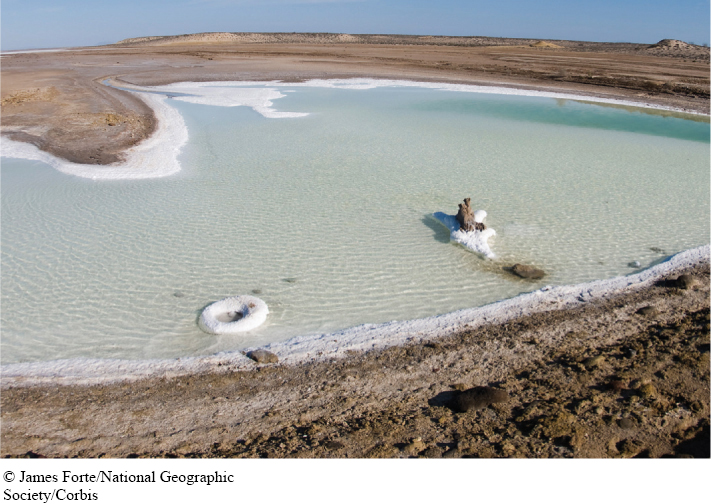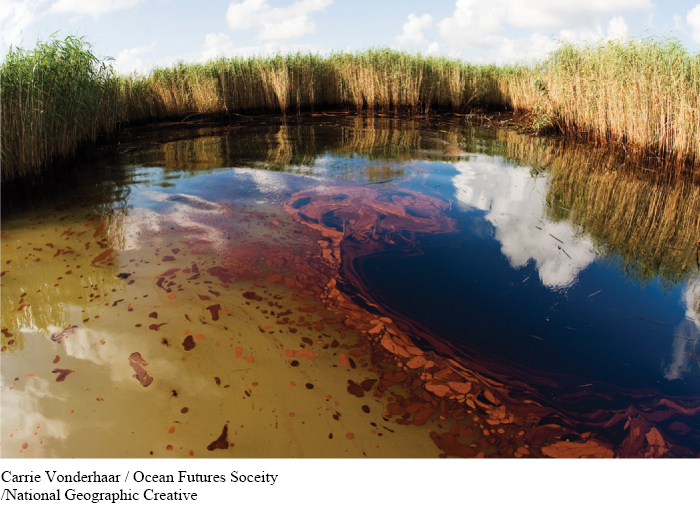13.12: Archaea thrive in habitats too extreme for most other organisms.
Archaea are famous for their ability to live in places where life would seem to be impossible, such as in water around hydrothermal vents that emerge from the seafloor, which would be boiling if it were at sea level. At 2,000 meters below the surface, the water pressure reaches 200 atmospheres, or almost 3,000 pounds per square inch, and the 400° C water coming from the vent cannot boil. Archaea thrive there. Most organisms die at temperatures between 40° and 50° C, because their protein molecules are denatured, so the ability of archaea to survive at temperatures above 100° C is truly remarkable.
Equally impressive is the ability of archaea to live in water as acidic as pH 0 or as salty as a saturated NaCl solution, and to metabolize an extraordinary range of compounds—

The extremophile nature of so many archaea leads to a practical problem that limits our knowledge of them. How do you grow an organism in your lab if it requires 200 atmospheres of pressure and a water temperature of 100° C or higher, and eats a gas that is toxic to humans? It’s not easy, and consequently only about one-
Extremophile archaea have important applications in bioengineering and environmental remediation. For example, Thermus aquaticus, an extremophile archaeon that lives in hot springs where the water is nearly boiling, produces an enzyme important in making PCR possible (see Chapter 5), and this enzyme is now sold for laboratory use under the name Taq polymerase. Far from being destroyed at high temperatures, Taq polymerase works best at 75° C, a temperature at which most human enzymes would simply fall apart.
“He was a killer, a thing that preyed, living on the things that lived, unaided, alone, by virtue of his own strength and prowess, surviving triumphantly in a hostile environment where only the strong survive.”
—JACK LONDON, The Call of the Wild, 1903
Bioengineers and biotechnologists believe that extremophile archaea and bacteria that thrive at high temperatures and pressures and metabolize toxic substances have enormous potential for industries that carry out activities under such conditions. Recent experiments have demonstrated the ability of some archaea to efficiently degrade hydrocarbons, making it possible for them to be used in the removal of sludge that accumulates in oil refinery tanks and, potentially, in the cleanup of contaminated environments such as oil slicks (FIGURE 13-18). Naturally occurring archaea are helping to break down some of the more than 200 million gallons of oil released into the Gulf of Mexico following an oil rig explosion and subsequent massive leak in 2010. Other archaea show promise in clearing mineral deposits from pipes in the cooling systems of power plants.

552
But not all archaea are extremophiles. Archaea live everywhere that bacteria do, and many of them live in places you would find comfortable. In fact, you are home to many archaea and, on occasion, some of them make their presence all too obvious.
Beans are notorious for their tendency to produce gas in the intestine, but archaea are actually the culprits (FIGURE 13-19). Beans contain a couple of carbohydrates with chemical bonds that are not broken down very well by any human enzymes. Methane-

TAKE-HOME MESSAGE 13.12
Archaea can tolerate extreme physical and chemical conditions that are impossible for most other living organisms. Archaea are hard to study, however, because many require extreme heat or pressure to grow, and these conditions are not easy to provide in a laboratory. Nonetheless, the ability of archaea to grow in such extreme conditions makes them potentially valuable for industrial and environmental purposes. Not all archaea are extremophiles; some live in moderate conditions and even in the human intestine.
What industrial applications might archaea be useful for? What characteristics of archaea make them suited for such tasks?
553